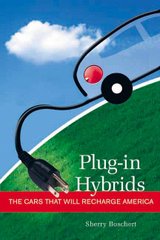Lutz says the Volt is no "pr stunt," that they intend to have a working model by the end of the year, and are making a diesel version with a European body to be shown in Frankfort. While the goal is still a 2010 release, everything hinges on the Lithium battery thought to be the essential heart of the Volt. And there's the rub. Must the battery really be lithium to get this radically different automobile off the drawing board and into the showroom? Or is lithium the new hydrogen? Simply the latest industry stalling tactic.
Asked why not Nickel Metal Hydride batteries in the Volt, at least to start, he says "NiMH just doesn't do it." It would take more weight to reach 40 miles, he says. And nickel mining is such dirty business we ought move right to benign lithium. But hold on. What's so sacrosanct about 40 miles? And is Lutz - purveyer of Hummers and Escalades - suggesting the environmental consequences of nickel mining are so great we must wait for lithium? Interestingly, Lutz says GM is being approached by NiMH manufacturers to use this proven battery chemistry in the Volt. And if Lithium proves problematic, he says GM will again consider NiMH.
This makes no sense. If you've got the desire to introduce a radically different car, why not simplify the effort by using the best available mature battery technology in the inevitably small-run first generation? If you've got hundreds of millions of trouble-free NiMH miles in hybrids and electric cars, why bet the bank on relatively untested if promising lithium?
Perhaps Lutz's mistaken impressions about the EV1 and electric cars color his understanding of what NiMH can achieve. (Or perhaps GM's disinformation campaign about the successes of the EV1 and its NiMH batteries is still in force.) He says the EV1 got 60-70 miles (actually double that), and very few were sold (actually none were sold) because people were afraid of getting stuck in LA traffic watching their charge go down ("stuck in traffic" requires virtually no energy.) Could Lutz not know the range of an EV1?
Lutz decries the lack of interest by the federal government in the "transformational technology" represented by the Volt.
We're curiously disappointed with all the talk about CO2 in Washington and we have to put industry's feet to the fire and improve fuel economy. Nobody really asks wouldn't it be smarter to put more energy into what you guys are doing with the Volt.Congressional efforts (and he might add environmental leadership at NRDC, UCS and the Sierra Club) are stuck on gasoline efficiency when it's time to move to technologies with the promise of getting us off petroleum.
"We are beyod the point of diminishing returns on the internal combustion engine. It's time to make a paradigm shift."Lutz expresses his belief in the benefits of transitioning to the electric grid, lessening our need for liquid fuels by using them merely as range extenders for an electric car. And I couldn't agree more. Does he mean it? Or is he simply asking to feed again at the federal trough, millions for lithium research much like the PNGV or various hydrogen and fuel cell research subsidies that have brought us neither fuel choices nor even high mileage gasoline vehicles.
If Lutz means it, GM should be willing to meet higher CAFE requirements with electric miles in the Volt, rather than ethanol flex-fuel loopholes.
If Lutz means it, GM should have no objection to a reinvigorated ZEV mandate in California. If he means it, GM should be working with CARB right now to include plug-in hybrids with all-electric range in the revised mandate.
If Lutz means what he says about the great benefits of the "E-Flex architecture," (what's more commonly known as a serial hybrid,) GM would demonstrate some real e-flexibility, and build a NiMH Volt now. GM doesn't need a fancy new package. And it doesn't need to have a $20,000 MSRP. There is a market for plug-in cars now.



2 comments:
I watched the PodTech video, and your assessment nails it, Marc. (Kudos to Matt Kelly of PodTech for asking Lutz the right questions!) Lutz contradicted himself about the NiMH batteries -- first saying they're not good enough, and then saying GM might use them in the end. Those of us who have been driving electric cars that have 3 times the range of the Chevy Volt on NiMH batteries know the batteries are good enough. Lutz is a good actor, but GM is stalling.
His comments about how Washington, D.C. should focus on supporting new technology rather than require higher fuel efficiency from gasoline cars sounds like another bait-and-switch, in the same way that Detroit's Big 3 automakers bamboozled the government in the 1990s with the Partnership for a New Generation of Vehicles. Like Marc said, if Lutz was serious about plug-in hybrids, he wouldn't mind higher CAFE standards, because PHEVs will exceed them.
Sherry Boschert, author
Plug-in Hybrids: The Cars that Will Recharge America
This stuff about nickel mining is so lame. The last time I analyzed the Dust to Dust hatchet job against hybrids, they claimed 1000 tons of nickel going into NiMH batteries, and blamed the devastation around the nickel mines in Sudbury Ontario on that, so I looked it up. World Nickel production was 1,425,509 tons in 2005. At 0.07%, the 1,000 tons attributed to the hybrid batteries is not the cause of Sudbury mine environmental devastation. In fact, 60% of nickel production goes into making steel according to Wikipedia [1]. So the Hummer, with all of its steel, is probably much more responsible for the Sudbury mine devastation than the Prius. Why isn't Lutz concerned about that?
[1] http://en.wikipedia.org/wiki/Nickel
Nickel consumption can be summarized as: nickel steels (60%), nickel-copper alloys and nickel silver (14%), malleable nickel, nickel clad and Inconel (9%), plating (6%), nickel cast irons (3%), heat and electric resistance alloys (3%), nickel brasses and bronzes (2%), others (3%).
Post a Comment